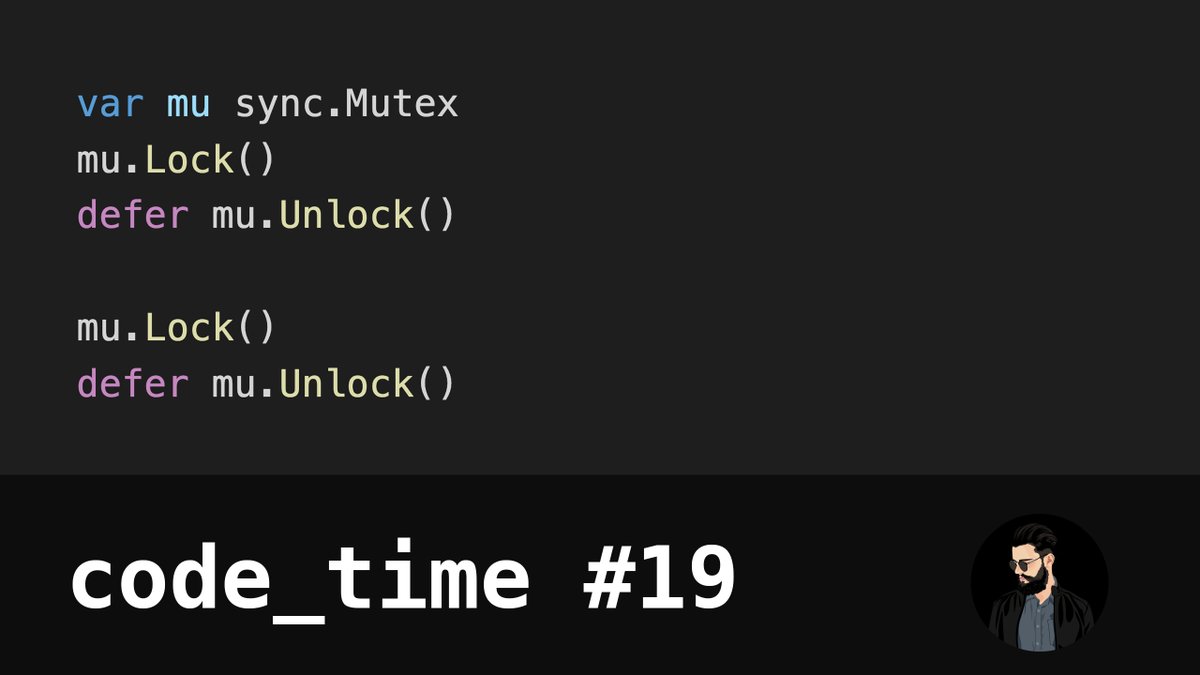#code_time search results
Go has most encoding standards supported, including its own encoding: gob for communicating between Go processes. So what's going to be the value of q? ✅ Q{A: 1, B: 2} ✅ Decode Error #steevehook #code_time #golang

This is a little tough one, but it's possible to do in Go. It's possible to run Assembly code and call Go code from Assembly. So what will be the result after running: go build -o exec ./exec ✅ result 5 ✅ ./main.go: missing function body #code_time #golang #steevehook

This one is a simple one & also a small teaser on what's coming. Will the 2nd statement execute? 🤔 ✅ YES ✅ NO #code_time #golang #concurrency #concurrency_in_go #steevehook

I'm sure you heard people in the Go community say "the select statement is just like the switch statement but for channels". Really? #code_time #golang #steevehook ✅ A: 1 channel 1 ✅ B: 2 channel 2 ✅ C: 3 channel 3 ✅ D: 1 2 3 channel 1 / channel 2 / channel 3

Kinda late from me, but still, here's your weekly quiz on Go's defer statement. Which snippet will print? ✅ Snippet 1 ✅ Snippet 2 #code_time #golang #steevehook

As usual, your weekly small quiz. This time, let's see how familiar you are with Go's Type System. What's it going to be? #code_time #golang #steevehook ✅ John ✅ Nobody ✅ Steve ✅ int32 ✅ int64 ✅ duplicate key error

Been a while since I hit ya with another code time. Here we go again. You might think locks in Go are re-entrant, to your surprise they're not. So what's it going to be? 🤔 ✅ Works fine ✅ Deadlock #code_time #golang #steevehook

It's CODE TIME again. As usual, your weekly quiz. This time let's see your experience with Go's sync.Once primitive. What's going to be the result? #code_time #golang #steevehook ✅ outside ✅ inside outside ✅ DEADLOCK

As usual gents, your weekly quiz. Let's see if you understand the meaning of the blank field inside a Go struct. Which initialisation will work without errors? #code_time #golang #go #steevehook ✅ unnamed fields ✅ named fields

Let's see if you're familiar with Asynchronous Preemption in Go. Even if you're not, stay tuned for a deep dive video about Concurrency. But still, WILL THE BELOW CODE PRINT?: #steevehook #code_time #golang ✅ YES ✅ NO ✅ Depends on the version of Go runtime

As usual another quiz to keep y'all sharp. This time let's see if you're familiar to Readers in Go. So what's going to be the output in case of a valid POST request with the body: "hello world"? ✅ invalid body ✅ body len: 0 ✅ body len: 11 #code_time #golang #go #steevehook

Have you ever asked yourself if the fields order inside a struct matters? Well, it actually does. The overall struct memory will be affected by the order of the fields in a struct. So what's it going to be? ✅ true ✅ false #code_time #golang #steevehook

Which snippet will exit after the timeout of 3 seconds? Hint: It has nothing to do with Concurrency in Go or what kind of channels are being used. In fact both APIs under the hood use the same NewTimer function. #code_time #golang #steevehook ✅ Snippet 1 ✅ Snippet 2

If there's anything easy to use in the sync package, that's the WaitGroup type. What do you think it's wrong with this code though? ✅ Everything will work just fine ✅ panic: sync: WaitGroup is reused before previous Wait has returned #code_time #golang #steevehook

I gotta say this one gets me very often. It's very important to be aware on what type of receivers you implement interfaces and how to instantiate types correctly. So which type will print Steve Steve (call the String method) ✅ person1 ✅ person2 #code_time #golang #steevehook

Can’t wait. Been looking to steal some quizzes. I ran out of quizzes for #code_time 😋
Can’t wait. Been looking to steal some quizzes. I ran out of quizzes for #code_time 😋
Go has most encoding standards supported, including its own encoding: gob for communicating between Go processes. So what's going to be the value of q? ✅ Q{A: 1, B: 2} ✅ Decode Error #steevehook #code_time #golang

Been a while since I hit ya with another code time. Here we go again. You might think locks in Go are re-entrant, to your surprise they're not. So what's it going to be? 🤔 ✅ Works fine ✅ Deadlock #code_time #golang #steevehook

This one is a simple one & also a small teaser on what's coming. Will the 2nd statement execute? 🤔 ✅ YES ✅ NO #code_time #golang #concurrency #concurrency_in_go #steevehook

This is a little tough one, but it's possible to do in Go. It's possible to run Assembly code and call Go code from Assembly. So what will be the result after running: go build -o exec ./exec ✅ result 5 ✅ ./main.go: missing function body #code_time #golang #steevehook

I gotta say this one gets me very often. It's very important to be aware on what type of receivers you implement interfaces and how to instantiate types correctly. So which type will print Steve Steve (call the String method) ✅ person1 ✅ person2 #code_time #golang #steevehook

If there's anything easy to use in the sync package, that's the WaitGroup type. What do you think it's wrong with this code though? ✅ Everything will work just fine ✅ panic: sync: WaitGroup is reused before previous Wait has returned #code_time #golang #steevehook

Have you ever asked yourself if the fields order inside a struct matters? Well, it actually does. The overall struct memory will be affected by the order of the fields in a struct. So what's it going to be? ✅ true ✅ false #code_time #golang #steevehook

As usual, your weekly small quiz. This time, let's see how familiar you are with Go's Type System. What's it going to be? #code_time #golang #steevehook ✅ John ✅ Nobody ✅ Steve ✅ int32 ✅ int64 ✅ duplicate key error

It's CODE TIME again. As usual, your weekly quiz. This time let's see your experience with Go's sync.Once primitive. What's going to be the result? #code_time #golang #steevehook ✅ outside ✅ inside outside ✅ DEADLOCK

Let's see if you're familiar with Asynchronous Preemption in Go. Even if you're not, stay tuned for a deep dive video about Concurrency. But still, WILL THE BELOW CODE PRINT?: #steevehook #code_time #golang ✅ YES ✅ NO ✅ Depends on the version of Go runtime

As usual gents, your weekly quiz. Let's see if you understand the meaning of the blank field inside a Go struct. Which initialisation will work without errors? #code_time #golang #go #steevehook ✅ unnamed fields ✅ named fields

Something went wrong.
Something went wrong.
United States Trends
- 1. #AEWDynamite 12K posts
- 2. Blake Snell 5,203 posts
- 3. JUNGWOO 11.1K posts
- 4. #Survivor49 2,088 posts
- 5. Donovan Mitchell 4,045 posts
- 6. doyoung 18.1K posts
- 7. Cavs 7,171 posts
- 8. Yesavage 5,454 posts
- 9. #SistasOnBET N/A
- 10. #AbbottElementary 1,362 posts
- 11. Kacie N/A
- 12. Okada 3,971 posts
- 13. Mobley 1,635 posts
- 14. Jaylen Brown 6,737 posts
- 15. #LoveIsBlindReunion N/A
- 16. Davis Schneider 4,907 posts
- 17. Game 5 57.2K posts
- 18. Trae Young 2,212 posts
- 19. Liverpool 192K posts
- 20. Blood and Guts N/A





